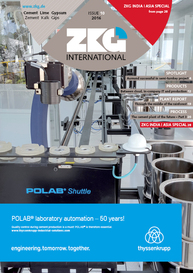The Indian cement industry
The Indian cement industry, currently in its 103rd year of existence, has a 7 % share in global cement production. Technologically, Indian cement plants are comparable with the best in the world. In the past two decades, the Indian cement industry has transformed from being a wet process-based to a dry process-based industry. Today, more than 99 % of the plants are based on the modern dry process. The Indian cement industry with over 410 million t/a capacity and about 270 million t/a production is the second largest in the world.
The measures taken by the industry have led to considerable gains in energy conservation and environmental improvement. The best Indian cement plants have reported 678 kcal/kg clinker thermal energy consumption and 71 kWh/t cement electrical energy consumption. Average specific energy consumption (SCE) has also shown a continuous downward trend and reached the level of 721 kcal/kg clinker and 76 kWh/t cement; CO2 emissions are down to the level of 0.719 t of CO2/t cement. The initiatives adopted by the Indian cement industry towards the utilization of secondary materials are evident from the fact that the production of blended cements was as high as 72 %. Indian Standards for composite cement have recently been released and in the coming years this will lead not only to saving of precious limestone but will also reduce GHG emissions and further decrease the carbon footprint of the industry. The NCB has been actively associated with the Global Cement Sustainability Initiative (CSI), a part of the World Business Council on Sustainable Development (WBCSD), on a key project to assess opportunities for carbon emission reduction and increased resource efficiency in the cement manufacturing process in India. This has resulted in a Low Carbon Technology Roadmap for the Indian Cement Industry wherein CO2 emissions are estimated to be reduced to 0.58 t CO2/t of cement by 2020 and 0.35 t CO2/t of cement by 2050.
The Indian economy is expected to grow at a rate of between 8-8.5 %. With clearing of GST (Goods and Services Tax) the Indian economy, and therefore the Indian cement industry, has very positive expectations for the next and coming years. Structural changes underway in India would place the economy on a stronger footing. The Indian government’s efforts for making India, the manufacturing hub of the world through “Skill India” and the “Make in India” programmes are further expected to contribute to India’s growth story. It is expected that government initiatives like “Make in India”, “Clean India mission”, “100 smart cities”, “Housing for all”, “World-class cement concrete highways”, “Dedicated freight corridors” and “Ultra mega power projects” would stimulate cement demand in the coming years and the projected demand for cement in 2022 would be in excess of 600 million t.
Ashwani Pahuja
Director General // National Council for Cement and Building Materials







